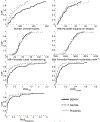Physical Performance Measures Correlate with Head Impact Exposure in Youth Football
- PMID: 31469712
- PMCID: PMC6962548
- DOI: 10.1249/MSS.0000000000002144
Physical Performance Measures Correlate with Head Impact Exposure in Youth Football
Abstract
Purpose: Head impact exposure (HIE) (i.e., magnitude and frequency of impacts) can vary considerably among individuals within a single football team. To better understand individual-specific factors that may explain variation in head impact biomechanics, this study aimed to evaluate the relationship between physical performance measures and HIE metrics in youth football players.
Methods: Head impact data were collected from youth football players using the Head Impact Telemetry System. Head impact exposure was quantified in terms of impact frequency, linear and rotational head acceleration, and risk-weighted cumulative exposure metrics (RWELinear, RWERotational, and RWECP). Study participants completed four physical performance tests: vertical jump, shuttle run, three-cone, and 40-yard sprint. The relationships between performance measures, and HIE metrics were evaluated using linear regression analyses.
Results: A total of 51 youth football athletes (ages, 9-13 yr) completed performance testing and received combined 13,770 head impacts measured with the Head Impact Telemetry System for a full season. All performance measures were significantly correlated with total number of impacts in a season, RWELinear-Season, and all RWE-Game metrics. The strongest relationships were between 40-yard sprint speed and all RWE-Game metrics (all P ≤ 0.0001 and partial R > 0.3). The only significant relationships among HIE metrics in practice were between shuttle run speed and total practice impacts and RWELinear-Practices, 40 yard sprint speed and total number of practice impacts, and three-cone speed and 95th percentile number of impacts/practice.
Conclusions: Generally, higher vertical jump height and faster times in speed and agility drills were associated with higher HIE, especially in games. Physical performance explained less variation in HIE in practices, where drills and other factors, such as coaching style, may have a larger influence on HIE.
Conflict of interest statement
The authors report no conflict of interest concerning the materials or methods used in this study or the findings specified in this paper. The results of the present study do not constitute endorsement by ACSM. The results of the study are presented clearly, honestly, and without fabrication, falsification, or inappropriate data manipulation.
Figures
Similar articles
-
Comparison of head impact exposure in practice drills among multiple youth football teams.J Neurosurg Pediatr. 2019 Mar 1;23(3):381-389. doi: 10.3171/2018.9.PEDS18314. Epub 2018 Dec 21. J Neurosurg Pediatr. 2019. PMID: 30579266 Free PMC article.
-
Head Impact Exposure and Neurologic Function of Youth Football Players.Med Sci Sports Exerc. 2015 Aug;47(8):1567-76. doi: 10.1249/MSS.0000000000000591. Med Sci Sports Exerc. 2015. PMID: 25437194
-
Head impact exposure measured in a single youth football team during practice drills.J Neurosurg Pediatr. 2017 Nov;20(5):489-497. doi: 10.3171/2017.5.PEDS16627. Epub 2017 Sep 12. J Neurosurg Pediatr. 2017. PMID: 28937917 Free PMC article.
-
Abnormalities in Diffusional Kurtosis Metrics Related to Head Impact Exposure in a Season of High School Varsity Football.J Neurotrauma. 2016 Dec 1;33(23):2133-2146. doi: 10.1089/neu.2015.4267. Epub 2016 May 18. J Neurotrauma. 2016. PMID: 27042763 Free PMC article.
-
Head Games: A Systematic Review and Meta-analysis Examining Concussion and Head Impact Incidence Rates, Modifiable Risk Factors, and Prevention Strategies in Youth Tackle Football.Sports Med. 2022 Jun;52(6):1259-1272. doi: 10.1007/s40279-021-01609-4. Epub 2021 Dec 11. Sports Med. 2022. PMID: 34894348
Cited by
-
Relationship between Aggressiveness, Self-Confidence, and Perceived Coach Support and Head Impact Exposure in Youth Football.Sports (Basel). 2022 Jul 29;10(8):115. doi: 10.3390/sports10080115. Sports (Basel). 2022. PMID: 36006081 Free PMC article.
-
Characterizing Exposure to Head Acceleration Events in Youth Football Using an Instrumented Mouthpiece.Ann Biomed Eng. 2022 Nov;50(11):1620-1632. doi: 10.1007/s10439-022-03097-7. Epub 2022 Oct 23. Ann Biomed Eng. 2022. PMID: 36274103 Free PMC article.
-
Characterization of Head Acceleration Exposure During Youth Football Practice Drills.J Appl Biomech. 2023 Apr 27;39(3):157-168. doi: 10.1123/jab.2022-0196. Print 2023 Jun 1. J Appl Biomech. 2023. PMID: 37105545 Free PMC article.
-
Leveraging football accelerometer data to quantify associations between repetitive head impacts and chronic traumatic encephalopathy in males.Nat Commun. 2023 Jun 20;14(1):3470. doi: 10.1038/s41467-023-39183-0. Nat Commun. 2023. PMID: 37340004 Free PMC article.
-
On-Field Evaluation of Mouthpiece-and-Helmet-Mounted Sensor Data from Head Kinematics in Football.Ann Biomed Eng. 2024 Oct;52(10):2655-2665. doi: 10.1007/s10439-024-03583-0. Epub 2024 Jul 25. Ann Biomed Eng. 2024. PMID: 39058402 Free PMC article.
References
Publication types
MeSH terms
Grants and funding
LinkOut - more resources
Full Text Sources



